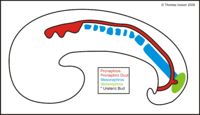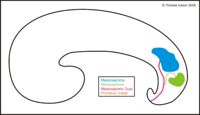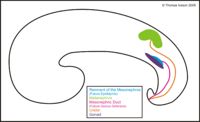Kidney and Urinary Tract Development - Anatomy & Physiology
The Kidneys
The kidneys are formed from the intermediate mesoderm. Firstly it begins to thicken longitudinally in its caudal domain. This is called the nephrogenic thickening. From this thickening three so called attempts at producing excretory origins arise. All the attempts have at the histological level a series of excretory tubules however only one of these attempts forms the kidney in adult life.
The Pronephros
This structure forms in the neck region of the embryo and is not functional in mammals. Its tubules attach and form the continuous pronephric duct. The caudal edge of this duct then opens into the cloaca. The duct survives the regression of the tubules and actually helps drain the mesonepohric tubules which begin to appear at this point.
The Mesonephros
This structure forms in the thoracic and lumbar regions and is important in embryonic life. It has more tubules than the pronephros and the structure of these tubules is similar to that of the adult kidney. They are closed at one end and open at the other. The open end drains into the pronephric duct which is now more appropriately called the mesonephric duct. The closed end has a bundle of capillaries which form a filtration mechanism. This organ is variable in size in relation to how efficient the placenta is at removing waste. The worse the placenta the bigger the organ. As the metanephros develops it supersedes this organ and it begins to regress as a result. Parts of it do, however remain in the male and form part of the ductus deferens.
The Metanephros
The metanephros forms from 2 primordia. One is an out growth of the ureteric bud which grows from the lower part of mesonephric duct near the cloaca. The bud grows up into the metanephros and divides. The early divisions later go on to be reabsorbed to a variable degree accounting for the inter-species differences in the renal pelvis and calyces. The later divisions form the collecting ducts. A mass of tissue is seen which is termed the metanephric mass. The outer part of this mass goes on to form the renal capsule and interstitium. The inner part goes on to form the nephrons via intermediates called cell cords. Each cell cord joins with a collecting duct. The other end invaginates around a tuft of capillaries arising from the aorta to form the glomerulus.
Lower Urinary Tract
The urinary tract comes from the horizontal division of the primitive hind gut in the cloacal region. This separation is done by a wedge of mesoderm called the urorectal septum. This wedge is located between the hindgut and the allantoic bud. The wedge grows until it reaches the cloacal membrane and has thus then divided the original hindgut into dorsal (anal) and ventral (urogenital) parts. The divide is termed the perineal body. The cloacal membrane covering the urogenital opening then breaks down forming the urogenital passage. This passage splits in cranial and caudal parts with the cranial part comprising the bladder and eventually the allantois and the caudal part comprising the urethra.
The Bladder
The widening of the cranial part of the urogenital passage forms the bladder. It is connected caudally to a closed urethra and cranially to a wide allantoic duct (the urachus). This connects the bladder to the allantoic sac outside the embryo which collects urine during foetal life. At birth the urachus degenerates and closes however there is usually a scar on the wall of the bladder. The ends of the meso and metanephric ducts are attached to the urogenital passage. The metanephric ducts form the ureters and enter the bladder. The mesonephric ducts enter more caudally in the urogenital sinus. The mesoderm from the mesonephric ducts forms epithelium of the trigone of the bladder. The remaining epithelium comes from the endothelium of the hindgut and the external layers are derived from local mesoderm.
The Urethra
As previously mentioned the caudal part of the urogenital passage forms the urethra. In females it forms the whole urethra however in males it is added to by the penile urethra which develops separately as part of the genitals.
Pathology
Details of pathology relating to this section can be found here
Error in widget FBRecommend: unable to write file /var/www/wikivet.net/extensions/Widgets/compiled_templates/wrt66219d37108ad4_07271051 Error in widget google+: unable to write file /var/www/wikivet.net/extensions/Widgets/compiled_templates/wrt66219d3713cf61_03623790 Error in widget TwitterTweet: unable to write file /var/www/wikivet.net/extensions/Widgets/compiled_templates/wrt66219d37168346_32322746
|
| WikiVet® Introduction - Help WikiVet - Report a Problem |


